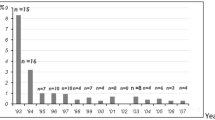Abstract
Background
By common perspective, it is generally considered that laparoscopic inguinal hernia repairs (LIHR) are comparable to conventional operative methods, as an equivalent treatment methodology in the management of inguinal hernias. The results of current studies, however, favour an LIHR in comparison to an open mesh repair (OMR) in selected patient populations. The advantages of LIHR lie in the clearer view of the spermatic cord contents it offers, and, as a result, it is a safer method in the preservation of testicular function, with fewer incidences of acute and chronic pain, and a significantly better quality of life postoperatively in comparison to OMR. One of the last unexplained questions regarding LIHR techniques (especially concerning the transabdominal preperitoneal inguinal hernia repair (TAPP) operation) was with regards to the fixation of the mesh. The goal of this study, based on single-centre prospective collection of data from the Internet-based multicentre Herniamed® register, is to demonstrate the safety and efficacy of the use of Parietex™ ProGrip™ Laparoscopic mesh in standardized LIHR with the TAPP technique.
Methods
Data analysis encompassed all patients who underwent inguinal hernia surgery within the period from May 1, 2013 to December 31, 2014, who fulfilled the inclusion criteria. There were two surgeons with experience in this particular technique contributing on the surgeries. Data were entered and subsequently analysed on the Herniamed® platform. All patients were managed in compliance with a standard protocol and were then re-evaluated 1 and 12 months postoperatively with a standardized questionnaire. Patients with a fixed scrotal hernia or an American Society of Anesthesiologists (ASA) stage IV were excluded from the study.
Results
In total, 95 patients were listed in the prospective, completely processed documentation on the Herniamed® platform. In total, 156 hernias were operated on. From the demographic point of view, there were 85 men (89.47 %) and 10 women (10.53 %). Representation of females in the group was around one-tenth: 10/95 (10.53 %), while these were mostly bilateral hernias. The average operation time was 64 min, while time taken for bilateral hernias was 67 min. Majority of operated hernias, i. e. 143 hernias (91.67 %) had hernia openings of moderate and large sizes (types 2 and 3, >1.5 cm and <4 cm); medial hernias were predominant on both sides. During the surgery, no complications were demonstrated; postoperative complications were evaluated as significant in relation to previous surgical procedures (major) and as less significant (minor), which did not influence the duration of hospitalization, and these were managed conservatively on an outpatient basis. Postoperative pain of moderate degree (4–6 Visual analogue scale [VAS]) lasting over 3 months in the groin was reported in one case (1.05 %). At the 1‑year assessment, mild discomfort was reported in the groin in 2 from 57 patients (3.51 %), which had no effect on any patient’s usual activity and did not require any therapy (1–3 VAS). After 1 year, there was no patient with chronic postherniorrhaphy inguinal pain (CPIP) reported. There was no recurrence of inguinal hernia confirmed in the followed-up group.
Conclusion
The legitimacy of the use of the self-fixation mesh was demonstrated in an experiment, in open inguinal hernia repair, laparoscopic totally extraperitoneal hernioplasty (TEP) technique and in TAPP technique. Our study demonstrates that LIHR using the TAPP technique with implantation of a new Parietex™ ProGrip™ laparoscopic self-fixation mesh is a fast, effective and reliable method in experienced hands, which combines the advantages of laparoscopic approach with simple and practical implantation of self-fixation mesh, which, according to our results, reduces the occurrence of CPIP and the recurrence rate.


Similar content being viewed by others
References
Birk D, Hess S, Garcia-Pardo C. Low recurrence rate and low chronic pain associated with inguinal hernia repair by laparoscopic placement of Parietex ProGrip™ mesh: Clinical outcomes of 220 hernias with mean follow-up at 23 months. Hernia. 2013;17:313–320. doi:10.1007/s10029-013-1053-3.
Miserez M, Peeters E, Aufenacker T, Bouillot JL, Campanelli G, Conze J, et al. Update with level 1 studies of the European Hernia Society guidelines on the treatment of inguinal hernia in adult patients. Hernia. 2014;18:151–163. doi:10.1007/s10029-014-1236-6.
Bittner R, Schwarz J. Inguinal hernia repair: Current surgical techniques. Langenbecks Arch Surg. 2011;397:271–282. doi:10.1007/s00423-011-0875-7.
Kosai N, Sutton PA, Evans J, Varghese J. Laparoscopic preperitoneal mesh repair using a novel self-adhesive mesh. J Minim Access Surg. 2011;7(3):192–194. doi:10.4103/0972-9941.83514.
Bittner R, Arregui ME, Bisgaard T, Dudai M, Ferzli GS, Fitzgibbons RJ, et al. Guidelines for laparoscopic (TAPP) and endoscopic (TEP) treatment of inguinal hernia. Surg Endosc. 2011;25:2773–2843, International Endohernia Society (IEHS) doi:10.1007/s00464-011-1799-6.
Author information
Authors and Affiliations
Corresponding author
Ethics declarations
Conflict of interest
P. Klobusicky and D. Hoskovec state that there are no conflicts of interest.
Ethical standards
All studies on humans described in the present manuscript were carried out with the approval of the responsible ethics committee and in accordance with national law and the Helsinki Declaration of 1975 (in its current, revised form). Informed consent was obtained from all patients included in studies.
Additional information
The supplement is dedicated to Jubilee World congress of International College of Surgeons 2015.
The publishing was sponsored by the Ministry of Health of the Czech Republic.
Rights and permissions
About this article
Cite this article
Klobusicky, P., Hoskovec, D. Use of an anatomical self-gripping Progrip™ laparoscopic mesh in TAPP hernia repair. Possible standard? Preliminary results of a prospective study. Eur Surg 48 (Suppl 2), 149–154 (2016). https://doi.org/10.1007/s10353-016-0406-4
Received:
Accepted:
Published:
Issue Date:
DOI: https://doi.org/10.1007/s10353-016-0406-4




